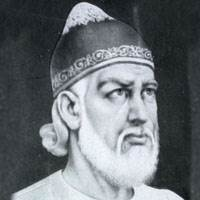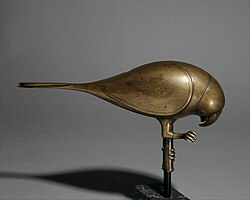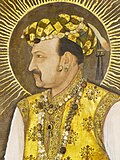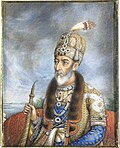Mughal Empire | |||||||||||||
|---|---|---|---|---|---|---|---|---|---|---|---|---|---|
| c. 1526–1857 | |||||||||||||
 The empire at its greatest extent c. 1700, under Aurangzeb | |||||||||||||
| Status | Empire | ||||||||||||
| Capital |
| ||||||||||||
| Official languages | Persian | ||||||||||||
| Common languages | See Languages of South Asia | ||||||||||||
| Religion | |||||||||||||
| Government | Monarchy | ||||||||||||
| Emperor | |||||||||||||
• 1526–1530 (first) | Babur | ||||||||||||
• 1837–1857 (last) | Bahadur Shah II | ||||||||||||
| Vicegerent | |||||||||||||
• 1526–1540 (first) | Mir Khalifa | ||||||||||||
• 1794–1818 (last) | Daulat Rao Sindhia | ||||||||||||
| Grand Vizier | |||||||||||||
• 1526–1540 (first) | Mir Khalifa | ||||||||||||
• 1775–1797 (last) | Asaf-ud-Daula | ||||||||||||
| Historical era | Early modern | ||||||||||||
| 21 April 1526 | |||||||||||||
| 17 May 1540–22 June 1555 | |||||||||||||
| 5 November 1556 | |||||||||||||
| 21 April 1526–3 April 1752 | |||||||||||||
| 1680–1707 | |||||||||||||
| 1738–1740 | |||||||||||||
| 21 September 1857 | |||||||||||||
| 7 October 1858 | |||||||||||||
| Area | |||||||||||||
| 1690 [2] [3] [4] | 4,000,000 km2 (1,500,000 sq mi) | ||||||||||||
| Population | |||||||||||||
• 1595 | 125,000,000 [5] | ||||||||||||
• 1700 | 158,400,000 [6] | ||||||||||||
| Currency | Rupee, Taka, dam [7] | ||||||||||||
| |||||||||||||
| Today part of | |||||||||||||
The Mughal Empire was an early modern empire that ruled most of the Indian subcontinent. At its peak, the empire stretched from the outer fringes of the Indus River Basin in the west, northern Afghanistan in the northwest, and Kashmir in the north, to the highlands of present-day Assam and Bangladesh in the east, and the uplands of the Deccan Plateau in South India. [8] [9]
Contents
- Name
- History
- Babur and Humayun (1526–1556)
- Akbar to Aurangzeb (1556–1707)
- Decline (1707–1857)
- Causes of decline
- Administration and state
- Administrative divisions
- Capitals
- Law
- Economy
- Coinage
- Labour
- Agriculture
- Industrial manufacturing
- Bengal Subah
- Demographics
- Population
- Urbanisation
- Culture
- Customs
- Architecture
- Art and literature
- Language
- Military
- Gunpowder warfare
- Rocketry and explosives
- Science
- Astronomy
- Metallurgy
- List of emperors
- See also
- References
- Footnotes
- Citations
- Sources
- Further reading
- Culture 2
- Society and economy
- Primary sources
- Older histories
- External links
The Mughal Empire is conventionally said to have been founded in 1526 by Babur, a ruler from what is now Uzbekistan, who with the help of the neighbouring Safavid and Ottoman Empires [10] defeated the sultan of Delhi, Ibrahim Lodi, in the First Battle of Panipat and swept down the plains of North India. The Mughal imperial structure, however, is sometimes dated to 1600, to the rule of Babur's grandson, Akbar. [11] This imperial structure lasted until 1720, shortly after the death of the last major emperor, Aurangzeb, [12] [13] during whose reign the empire also achieved its maximum geographical extent. Reduced subsequently to the region in and around Old Delhi by 1760, the empire was formally dissolved by the British Raj after the Indian Rebellion of 1857.
Although the Mughal Empire was created and sustained by military warfare, [14] [15] [16] it did not vigorously suppress the cultures and peoples it came to rule; rather, it equalised and placated them through new administrative practices, [17] [18] and diverse ruling elites, leading to more efficient, centralised, and standardised rule. [19] The basis of the empire's collective wealth was agricultural taxes, implemented by the third Mughal emperor, Akbar. [20] [21] These taxes, which amounted to well over half the output of a peasant cultivator, [22] were paid in the well-regulated silver currency, [19] and allowed peasants and artisans to enter larger markets. [23]
The relative peace maintained by the empire during much of the 17th century was a factor in India's economic expansion. [24] The burgeoning European presence in the Indian Ocean and an increasing demand for Indian raw and finished products generated much wealth for the Mughal court. [25] There was more conspicuous consumption among the Mughal elite, [26] resulting in greater patronage of painting, literary forms, textiles, and architecture, especially during the reign of Shah Jahan. [27] Among the Mughal UNESCO World Heritage Sites in South Asia are: Agra Fort, Fatehpur Sikri, Red Fort, Humayun's Tomb, Lahore Fort, Shalamar Gardens, and the Taj Mahal, which has been described as "the jewel of Muslim art in India, and one of the universally admired masterpieces of the world's heritage". [28]











































